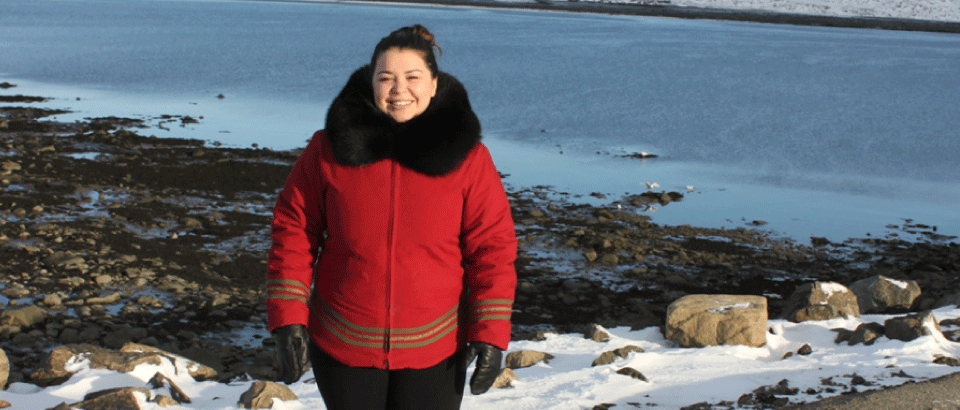APEX celebrates National Indigenous History Month and Indigenous Peoples Day
Public Service in Canada’s North
An Executive Guest Blog by Micheline Kilabuk-Cote, Director, Pilimmaksaivik in Iqaluit
We can all agree it has been an unprecedented year adapting to the COVID-19 pandemic and while most Canadians quickly adapted to roll out essential programs and services from the comfort of their living rooms, in Nunavut things can be there are challenges that limit the ability to progress in this new normal.
Today is a prime example. I’m writing from my home here in Iqaluit, Nunavut. It is June 1st and the unseasonably cool weather has me experiencing difficulties with my VPN connection – because it’s snowing. You’ve got that right. The snowfall in the Arctic impacts our broadband connectivity. This is mostly irritating more than anything, and I manage to call into the next MS Teams meeting from my landline; connection is spotty but I make do. I am very fortunate that my current living situation is comfortable, unlike the majority of the Inuit population in Nunavut. I manage to call into my scheduled Teams meeting from my landline and do my best to participate with the very spotty connection.
Just before the pandemic started in December 2019 I accepted a new challenge as the Director of Pilimmaksaivik (the Federal Centre of Excellence for Inuit Employment in Nunavut). I’ve been working with the Government of Canada in various roles since 2008 and with Pilimmaksaivik since its establishment in 2016. Supporting Inuit advancement in education, training and employment is my passion – to help Inuit understand the opportunities that are made available through Article 23 of the Nunavut Agreement, and to support the Government of Canada in advancing the objective to increase Inuit Employment to a representative level in Nunavut.
Before accepting this big life change I took extra thought and care to consider my options. I consulted with my close friends, and this happened to be around the same time that one of my closest friends, Tina DeCouto, was completing her fellowship paper ‘Uncomfortable Inuk – Exploring Inuit Qaujimajatuqangit’. Tina and I spent many late nights exploring and debating our complex paths where we sometimes cross professionally. We are the same age; we went to the same high school; but our lives took different paths entering adulthood. Tina works for a Nunavut Tunngavik Inc as the Director of Inuit Social and Cultural Development, and here I am. At the end of the day, it is our passion for advancing Inuit advancement that keeps are bond very close. She encouraged me to accept this opportunity – if not you, who else?
The last 15 months in my introductory year as an EX has been a roller coaster, much as I’m sure every other executive in this country also took a ride – quite the initiation! All to say, I am so thrilled to share that we the Pilimmaksaivik team accomplished so much during these trying times. Embodying Inuit Societal Values has definitely kept me grounded and on track for success, particularly Qanutuurniq, which translates to being innovative and resourceful.
As Inuit, we have always had to adapt for survival and adapting to this ‘new normal’ post pandemic was definitely survival mode. Through ikajuqtigiinniq (working collaboratively) Pilimmaksaivik activities were carried in a safe manner – intensive recruitment took place, learn to events were held and key pre-employment training programs continued. In December 2020, the Inuit Learning and Development Program graduated 9 participants in a virtual event that showcased each participants success and allowed for many program partners across the country to participate – something that would not have been possible pre-pandemic. A win!
Service delivery in the North is exceptionally important, and means that programs and services must reflect geographical and cultural considerations. When you have leaders from the North, and located in the North, making decisions on key programs and services, Northern communities are more likely to accept these programs. As an executive, I am proud to use my voice to share Inuit perspectives and tie them into the programs and services that we deliver.
For my fellow public service executives across Canada, I encourage you to think about your colleagues in Nunavut, Yukon and the Northwest Territories. The Arctic and the North is so rich with language and culture – try your best to learn the local Indigenous language (you can learn Inuktitut on https://tusaalanga.ca/welcome-bienvenue !). The next time you are on a call with Northerners, surprise them with your newfound language skills. Community members appreciate the extra effort.
This year has been challenging, but I’ve learned that the public service remains strong, resilient and resourceful – I’ve never witnessed so many departments and people come together to continue the hard work to achieve shared objectives.
Nakurmiik, Ulluqattiarit !

